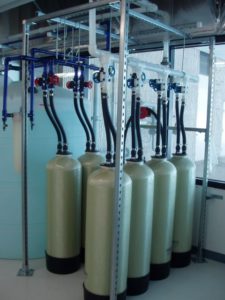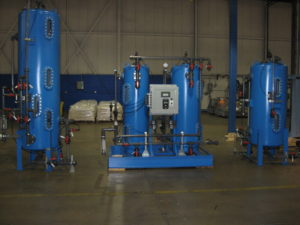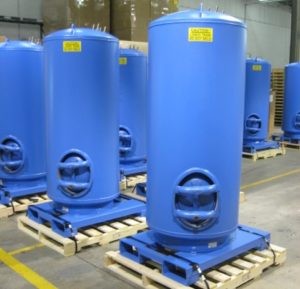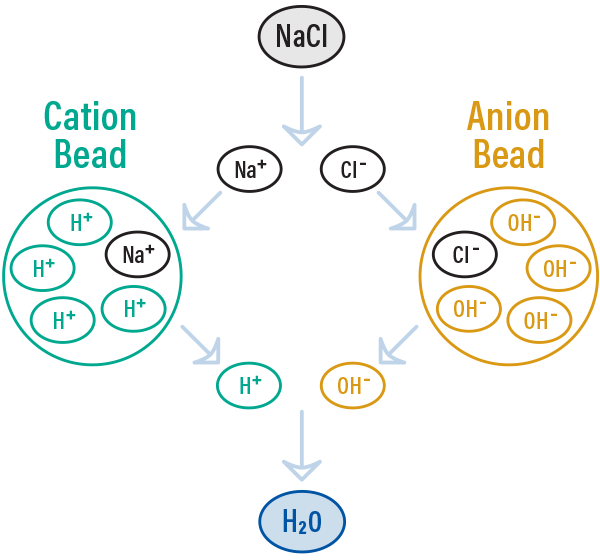Ion Exchange Regeneration Services

Portable ion exchange (SDI, Service DI) services consist of FRP vessels ranging in volume from 0.5 to 3.6 cubic feet that include cation, anion, mixed bed ion exchange resins and granular activated carbon. The ion exchange resin removes ionic contaminants that are harmful to an industrial or commercial/institutional environments. When ion exchange tanks are, exhausted and are unable to remove ionic impurities, they are replaced with freshly regenerated tanks. RODI Water Services Inc. provides the regeneration of the cation, anion, mixed bed ion exchange resins for both OEM and end users.
The portable ion exchange DI Water Tanks (also known as PEDI) require no chemical handling or maintenance. They provide a reliable source of deionized water (demineralized water) up to 18.2 Mega-ohm resistivity.
All of our ion exchange resin services are regenerated under current GMP (Good Manufacturing Practices). Only premium ion exchange resins are used to ensure consistent performance and throughput. Each batch of regenerated ion exchange resin is tested for both quality of effluent and throughput capacity. This guarantees the proper water quality and a predictable of resin capacity. Dedicated and isolated service deionization tanks are available along with full documentation and traceability.
Basics of Ion Exchange
Deionization is one of the most efficient processes for removing ionic dissolved salts and minerals from water. Ion exchange is a process where ions are exchanged for more desirable ions by using specific manufactured ion exchange resins. Ions are dissolved salts or minerals in water that need to be removed to generate high purity water that is used as a rinse or a product additive.

Granular Activated Carbon (GAC)
GAC (Granular activated carbon) removes chlorine and chloramines as well as many dissolved organic contaminants. It does not function on the principles of ion exchange, but a carbon vessel is commonly found as part of an ion exchange system or before an RO (reverse osmosis) unit to prevent damage from oxidation or organic fouling.
Twin Bed Cation & Anion Resin Systems
A dual bed system consists of a Cation resin vessel followed by either a Strong Base or Weak Base resin vessel. A Cation resin exchanges positively charged ionic contaminants such as calcium, magnesium, iron, manganese, potassium and sodium with the hydrogen (H+) ion. A Strong Base Anion resin exchanges negatively charged dissolved ionic contaminants such as chlorides, alkalinity (carbonate and bicarbonates), CO2 gas, sulfates, nitrates and silica for the hydroxyl ion (OH-). A Weak Base Anion Demineralizer removes the above contaminants with the exception of silica and C02. The resulting stream of water will consist of hydrogen (H+) and hydroxyl (OH-) that together form H20.
Mixed Bed Deionizers
 Mixed Bed Deionizers consist of Strong Acid Cation and Strong Base Anion ion exchange resins mixed together to produce a higher quality of deionized water with a more neutral pH. Typically, the water quality reaches a resistivity of up to 18.2 Mega-ohms (the highest possible level of deionization/distillation available). Inline conductivity/resistivity meters and quality lights alert an operator as to when the ion exchange tanks need to be replaced with fresh bottles. The picture below illustrates the functionality of a mixed bed resin vessel.
Mixed Bed Deionizers consist of Strong Acid Cation and Strong Base Anion ion exchange resins mixed together to produce a higher quality of deionized water with a more neutral pH. Typically, the water quality reaches a resistivity of up to 18.2 Mega-ohms (the highest possible level of deionization/distillation available). Inline conductivity/resistivity meters and quality lights alert an operator as to when the ion exchange tanks need to be replaced with fresh bottles. The picture below illustrates the functionality of a mixed bed resin vessel.
Typically, the water quality reaches a resistivity of up to 18.2 Mega-ohms (the highest possible level of deionization/distillation available). Inline conductivity/resistivity meters and quality lights alert an operator as to when the ion exchange tanks need to be replaced with fresh bottles.
The picture below illustrates the functionality of a mixed bed resin vessel.

